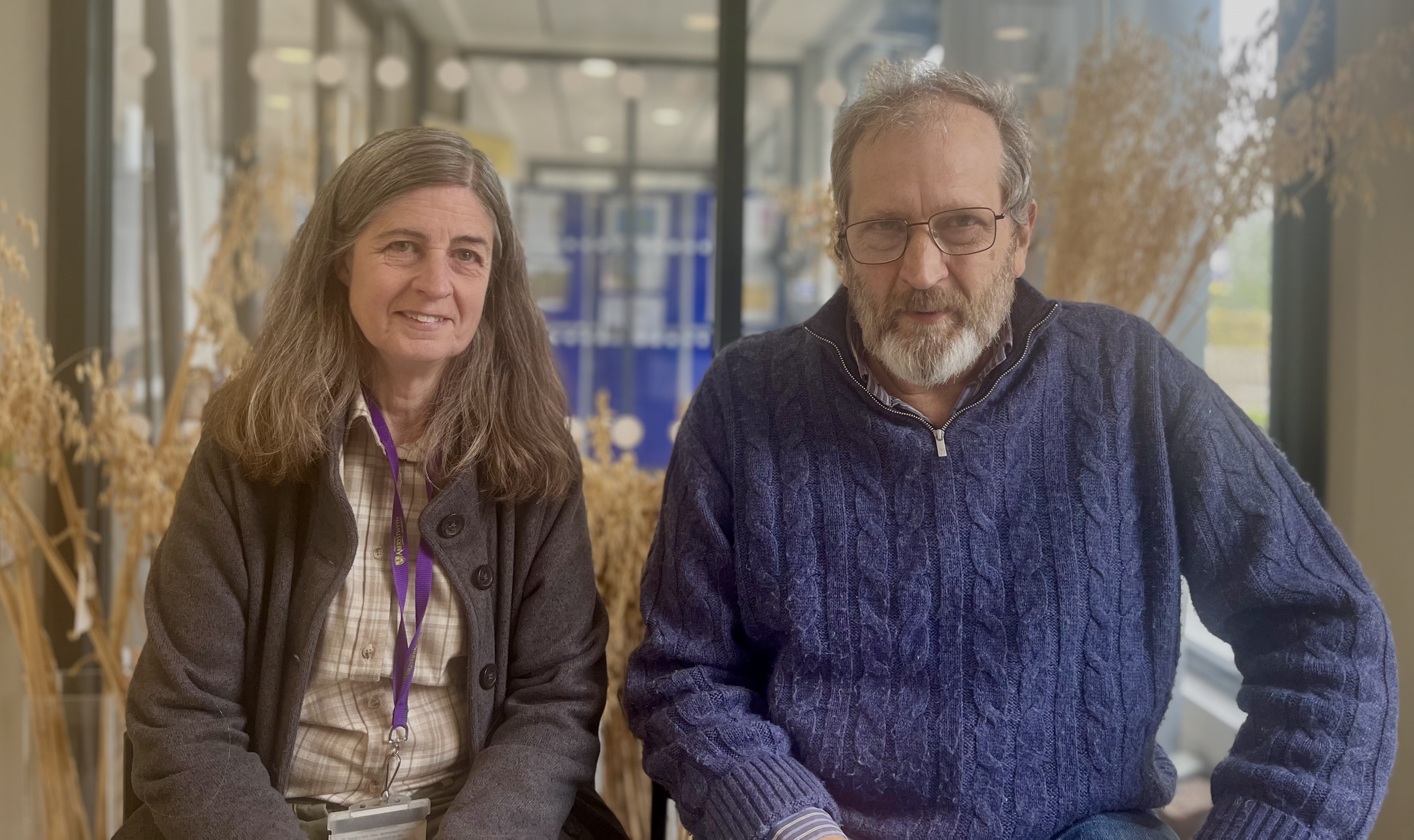New groundbreaking gene atlas could lead to healthier, climate-resistant oats

Dr Catherine Howarth and Dr Tim Langdon from the oat breeding research programme at Aberystwyth University’s Institute of Biological, Environmental and Rural Sciences (IBERS).
29 October 2025
Leading plant scientists from across the world have joined forces to catalogue the diversity of oats and their wild relatives, sequencing the full chromosomal complement of 33 of the most common types and mapping more than nine thousand in unprecedented detail.
Their breakthrough findings, published today in the prestigious journal Nature, will help plant breeders develop even better oat varieties and further enhance the significant health benefits of the crop, which is high in fibre, gluten-free and proven to lower cholesterol levels.
The international PanOat consortium, which includes the IBERS research institute at Aberystwyth University, also looked at how genes are expressed during development in different genetic backgrounds and has released the first oat pan-transcriptome, which is a major step forward in making practical use of the oat genome.
Unlocking the complex oat genome
Oats have been eaten by people and animals for thousands of years but their complex genomes have been difficult to understand until now, as Dr Tim Langdon from the oat research team at the Institute of Biological, Environmental and Rural Sciences (IBERS) at Aberystwyth, explains:
“Oats contain three genomes, each larger than the human one, and these genomes first combined in wild progenitors millions of years ago. Since then, wild oats have been shedding genes and rearranging chromosomes as they adapt to different environments.
“Modern breeding aims to combine the best traits from the various lineages that emerged, but those efforts may be hampered by a lack of understanding around how the genomes differ and how certain rearrangements of chromosomes can lead to incompatibility and failed crosses.
“Now, the PanOat consortium has created the most detailed pangenome ever – in effect, a gene atlas or library of all the different variants of oat you’re likely to come across in a breeding programme. This will significantly expand the genomic resources available to researchers and have an immediate impact on genomics-assisted plant breeding, helping to accelerate the development of even better oat varieties and bring benefits to consumers, farmers and millers as well as the wider environment.
“Understanding how to combine different lineages is particularly important for the UK which is unusual in growing winter oats. Transferring the right traits from spring or wild material has to go hand in hand with enhancing adaption to changing winter weather.”
IBERS’ research on the PanOat project was funded by the UKRI Biotechnology and Biological Sciences Research Council (BBSRC) and included the contribution of three complete oat genomes. The consortium is coordinated by the Leibniz Institute of Plant Genetics and Crop Plant Research (IPK) in Germany.
Informing oat breeding strategies
In a complementary study led by Agriculture and Agri-Food Canada (AAFC) with significant input from IBERS with BBSRC funding, scientists carried out a detailed analysis of the genetic variation of oats, examining more than 9,000 distinct varieties of wild and cultivated oats from across the world.
The aim of the study was to identify different genetic populations and how their structure has adapted to local environments. It revealed that cultivated oats resulted from multiple domestication of wild species, with reproductive barriers being caused by differential chromosome structure between populations. These findings are published in full today in the Nature Communications journal.
Dr Catherine Howarth, who leads the oat breeding research programme at IBERS, focused on analysing the structure of winter oats for the project, drawing on the extensive seed bank at Gogerddan, Aberystwyth, which stores varieties from all over the world - some dating back more than a century.
“One of the strengths of this project is the pooling of knowledge and expertise from across the globe. No single research institution would have the capacity to do work on this scale but together we’ve been able to map out an incredibly detailed genetic atlas for oats.
“We hope these findings and genomic tools will help inform targeted breeding strategies to develop climate-resilient oat varieties with improved yield stability and health benefits under changing environmental conditions.”
Professor Anne Ferguson-Smith, BBSRC Executive Chair, said:
“This landmark international collaboration is a powerful example of how cutting-edge bioscience can help tackle some of the greatest challenges we face, from improving the resilience of our food systems in a changing climate to supporting healthier diets for people around the world. By unlocking the complexity of the oat genome, researchers are opening new pathways for crop innovation that will improve lives and livelihoods for farmers, consumers and the environment alike.”
The findings of both studies are published in full in Nature and Nature Communications.



